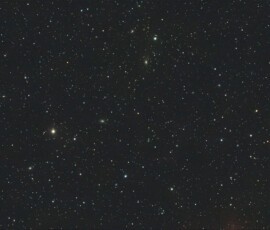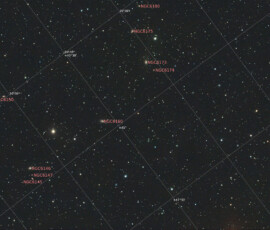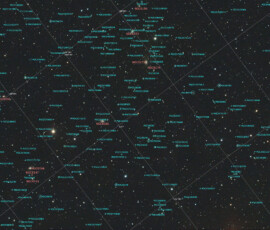Abell (ACO) 2197 is part of the great wall of galaxy clusters which includes the Coma Cluster (ACO 1656), the Leo Cluster (ACO 1367) and the Hercules Cluster (ACO 2151). It lies only a short distance on the sky, about 1.5 degrees, from ACO 2199 and there is evidence of a filament of galaxies linking these two clusters with ACO 2151. ACO 2197 and 2199 along with 2151, 2152, 2147 and 2162 comprise the Hercules Supercluster.
Classified as a type III cluster on the Bautz-Morgan system, ACO 2197 is a fairly irregular cluster containing 11 galaxies catalogued in the NGC. ACO 2197 is quite a large cluster in spatial terms covering almost 1.5 degrees in length on the sky. The cluster appears to form an E-W alignment based on the bright galaxies NGC 6146, NGC 6160 and NGC 6173, a line almost a degree long.
As with ACO 2199, ACO 2197 is dominated by a giant cD galaxy, in this case NGC 6173 along with two other giant ellipticals (NGC 6146 and NGC 6160). The cluster is thought to be at a distance of perhaps 126 Mpc. In terms of galaxy numbers ACO 2197 would appear to contain maybe 1500 galaxies or more, so it is quite a large cluster. It may also be interacting with ACO 2199 as the clusters may only be 9.2 Mpc apart in space.


